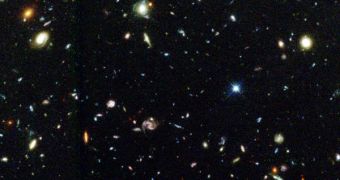Ever since Hubble got its new set of eyes, the Wide Field Camera 3 (WFC3), astronomers have been treated to a wealth of new scientific data of the Deep Field, a portion of the night skies just 1/12th of the surface of the Moon. The new observation instrument is very effective at its job, mostly because of its massively improved infrared detection capabilities. This allows it to determine the “redshift” of the specific cosmic object that is being studied, and thus find out its age. Now, astronomers believe they may have discovered a galaxy that is more than 13.2 billion years old, the oldest ever found.
Until now, the record was held by a gamma ray burst (GRB) with a redshift of 8.2, which was discovered this April. The redshift is essentially the process through which electromagnetic radiation (in this case light) shifts its energy to longer, less energetic wavelengths, such as the infrared wavelength. This is generally caused b the Doppler effect, or by other classes of cosmic, gravity-induced phenomena. Just recently, astronomers at the University of California in Santa Cruz (UCSC), led by expert Garth Illingworth, have announced in the journal arXiv that they found a cosmic source with a redshift of 10.
The objects were found in the Hubble Deep Field images, and the science group says that the recently identified galaxies must have existed when the Universe was about three to four percent its current age, of 13.7 billion years. “Even though it's not really unexpected, finding galaxies at such early times is hugely exciting. There's no smoking gun, but we're confident that this is what we're really seeing,” Illingworth explains. However, his team's announcement was not the first of a 10-redshift galaxy. Other teams also announced the discovery of such old galaxies in the Deep Field, Nature News reports.
For example, Arizona State University in Tempe expert Rogier Windhorst and his team managed to discover more than 20 galaxies with a redshift of 10 in the same data set that the UCSC group used. Granted, the two galactic groups that the teams found do not overlap. Difficulties, the experts say, arise from the fact that, at this point, it's still unclear how these distant galaxies should be defined. Illingworth says that Windhorst's team might have not taken into account a large number of factors pertaining to the accuracy of the investigation.
For example, the UCSC expert says, some of the 20 galaxies that Windhorst and his team believe they found at the beginning of the Universe may lie too close to more luminous, nearer galaxies, which may have tainted the results of the team's calculations. “That could have confused their software and caused them to get a lot of objects that just were not real high-redshift galaxies,” Illingworth believes. He also adds that 20 galaxies this old in such a small patch of skies would imply that the early universe had a much higher rate of stellar formation. “This doesn't accord with what we would expect theoretically or logically,” he adds.

 14 DAY TRIAL //
14 DAY TRIAL //